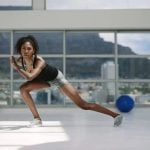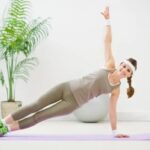Are you looking to elevate your fitness routine while having fun and getting your body moving? Look no further than a dance fitness warm up routine.
In this article, we will explore the benefits of incorporating dance into your warm up, how to set the mood with the perfect music, basic dance moves to get your body ready for a workout, tips for creating a safe routine, and even provide you with a sample 10-minute warm up routine to try at home or in the gym.
Dance fitness warm up routines are an excellent way to prepare your body for physical activity while also adding an element of enjoyment and creativity. By incorporating dance into your warm up, you can improve your flexibility, mobility, coordination, and overall cardiovascular health. This article will delve into the multiple benefits of a dance fitness warm up routine and how it can take your exercise regimen to the next level.
In addition to discussing the benefits of dance fitness warm ups, we will also provide guidance on setting the right mood with music selection, basic dance moves that you can incorporate into your routine, and even include flexibility and mobility exercises that can be integrated into your warm up.
Whether you’re new to dance or just looking for new ways to spice up your fitness routine, this article has something in store for everyone looking to embrace the power of dance in their workout warm ups.
Benefits of a Dance Fitness Warm Up Routine
Dance fitness warm up routines offer a wide range of benefits that go beyond simple physical preparation. In addition to preparing the body for the high energy demands of a dance fitness session, a well-structured warm up routine can also help to enhance mental focus and improve overall performance. By understanding the specific benefits of incorporating dance into your warm up routine, you can maximize the effectiveness of your workout and elevate your fitness experience.
Increased Cardiovascular Endurance
One of the key benefits of a dance fitness warm up routine is the improvement in cardiovascular endurance. The combination of dynamic movements and rhythmic patterns in dance not only helps to increase heart rate but also improves circulation, which in turn enhances stamina and endurance. This means that by incorporating dance into your warm up, you are not only warming up your muscles but also getting your heart pumping, setting the stage for a more effective workout.
Mental Engagement and Focus
Engaging in a dance fitness warm up routine requires coordination, rhythm, and concentration. As a result, this type of warm up can serve as a mental workout as well as a physical one.
With its emphasis on synchronization and timing, dancing can help sharpen cognitive skills such as spatial awareness, memory, and decision-making. This mental engagement can be particularly beneficial when transitioning from everyday activities to an intense fitness session, helping to shift focus away from external distractions and promote mindfulness.
Improved Mood and Stress Relief
The combination of music and movement in a dance fitness warm up routine has been shown to have positive effects on mood and stress levels. Dancing promotes the release of endorphins, which are natural mood lifters, while also providing an outlet for self-expression and creativity.
Additionally, the social aspect of group dance fitness classes can foster feelings of camaraderie and support among participants, further contributing to stress relief. By starting your workout with a dance-based warm up, you may find yourself feeling more energized, relaxed, and ready to tackle the challenges ahead.
Setting the Mood
Importance of Music in Warm Up
In any fitness routine, including a dance fitness warm up routine, music plays a crucial role in setting the mood and energy levels. The right music can help elevate the atmosphere and motivate participants to move with more enthusiasm and vigor.
When it comes to choosing music for your warm up, opt for upbeat and high-energy tunes that will get your heart pumping and your body moving. A good warm up playlist should include a mix of fast-paced tracks with varying tempos to keep things interesting.
Consider Your Audience
When selecting music for your dance fitness warm up routine, also consider the preferences and demographics of your audience. Different age groups or fitness levels may respond better to certain genres or styles of music.
For example, younger participants may enjoy current pop hits, while older individuals might appreciate classic tunes or familiar songs they can sing along to. Additionally, take into account any cultural or musical preferences that are relevant to your group in order to create an inclusive and enjoyable warm up experience for everyone.
Creating Seamless Transitions
Another important aspect to consider when choosing music for your warm up routine is creating seamless transitions between songs. This will ensure that the energy maintains consistency throughout the warm up session without abrupt stops or changes in tempo. Pay attention to the flow of the music and organize your playlist in a way that allows for smooth transitions from one song to the next, keeping the momentum going and keeping participants engaged throughout their dance fitness warm up routine.
Basic Dance Moves for an Effective Warm Up
When it comes to creating an effective dance fitness warm up routine, incorporating basic dance moves is essential. Not only do these moves help to raise the heart rate and increase blood flow, but they also set the stage for a fun and energizing workout. Basic dance moves such as side steps, grapevines, and simple choreographed sequences can help participants loosen up their muscles and get in the right mindset for a high-energy fitness session.
Incorporating basic dance moves into a warm up routine also allows participants to work on coordination and balance. These fundamental skills are not only beneficial for the actual workout, but they can also have positive effects on overall physical health and daily activities. By mastering basic dance moves in a warm up routine, individuals can improve their motor skills and enhance their overall physical performance.
One of the key benefits of integrating basic dance moves into a warm up routine is the engagement of various muscle groups. Dancing involves movements from the entire body, including the arms, legs, core, and even facial muscles. As a result, utilizing basic dance moves during a warm up helps to activate and prepare all of these muscle groups for more intense physical activity. This ultimately leads to a more effective workout and reduces the risk of injury.
| Benefit | Data |
|---|---|
| Improves coordination | By incorporating basic dance moves into a warm up routine, individuals can improve their coordination skills. |
| Engages multiple muscle groups | The use of dance moves in a warm up routine activates various muscle groups throughout the body. |
| Enhances balance | Practicing basic dance moves helps to improve balance which can benefit overall physical health. |
Incorporating Flexibility and Mobility Exercises Into Your Warm Up
Flexibility and mobility are crucial components of a successful dance fitness warm up routine. These exercises help to prepare the body for the dynamic movements and range of motion required during a dance workout. By incorporating flexibility and mobility exercises into your warm up, you can improve your overall performance, reduce the risk of injury, and enhance your dance experience.
Here are some essential flexibility and mobility exercises to include in your dance fitness warm up routine:
- Dynamic Stretches: Dynamic stretches involve continuous movement patterns that mimic the actions you will perform during your dance workout. Examples include leg swings, arm circles, and hip rotations. These stretches help to improve blood flow, increase joint mobility, and activate the muscles needed for dancing.
- Foam Rolling: Using a foam roller before your dance fitness session can help release muscle tightness and improve flexibility. Focus on areas such as the calves, quadriceps, hamstrings, and back to relieve tension and improve overall mobility.
- Mobility Drills: Incorporating mobility drills like shoulder rolls, spinal twists, and hip openers into your warm up routine can help to enhance range of motion and loosen stiff joints. These drills prepare the body for the intricate movements involved in various dance styles.
By including these flexibility and mobility exercises in your dance fitness warm up routine, you can optimize your performance while reducing the risk of muscle strains or injuries. Prioritizing flexibility and mobility will not only benefit your dancing abilities but also contribute to long-term physical well-being. Start off with these exercises to elevate the effectiveness of your warm-up routine before kicking off those intense moves.
Tips for Creating a Safe and Effective Warm Up Routine
When creating a dance fitness warm up routine, it is important to focus on safety and effectiveness. One of the first tips for creating a safe and effective warm up routine is to start with gentle movements that gradually increase in intensity. This allows your body to prepare for more strenuous activity and helps prevent injuries. Incorporating dynamic stretches, such as leg swings and arm circles, can also help improve flexibility and mobility while warming up the muscles.
Another tip for creating a safe and effective dance fitness warm up routine is to consider the specific movements and activities that will be performed during the main workout. For example, if your dance fitness session will involve a lot of hip movement or jumps, it’s important to incorporate warm up exercises that specifically target those areas. This can help prepare the body for the specific demands of the workout and reduce the risk of injury.
It’s also important to listen to your body when creating a warm up routine. While it’s important to challenge yourself during a warm up, it’s equally important to know your limits and not push yourself too hard too quickly. Pay attention to how your body feels during different movements and adjust the intensity of your warm up accordingly.
By following these tips, you can create a dance fitness warm up routine that is not only safe, but also effective in preparing your body for an intense workout session. Taking the time to carefully plan and execute a warm up routine can lead to improved performance, reduced risk of injury, and overall better results from your dance fitness workouts.
Sample 10-Minute Dance Fitness Warm Up Routine
When it comes to a dance fitness warm up routine, having a structured plan can make all the difference in preparing your body for a high-energy workout. A 10-minute warm up routine that incorporates both dance moves and flexibility exercises can set the stage for a successful fitness session. By following a consistent warm up routine, you can optimize your performance, reduce the risk of injury, and enhance your overall experience.
To begin your 10-minute dance fitness warm up routine, start by selecting upbeat and energetic music that will motivate you to move. The right music can help elevate your mood and get you in the right mindset for your workout.
Once you have chosen your music, stand with your feet hip-width apart and take deep breaths to focus on centering yourself. As the music builds, start with light cardio movements such as marching in place or stepping from side to side to increase your heart rate and circulation.
Next, incorporate basic dance moves into your warm up routine to further engage your muscles and improve coordination. Dance moves like grapevines, step touches, and simple choreographed sequences can add an element of fun and creativity to your warm up while also working on balance and agility. It’s important to keep the movements low-impact at this stage to gradually prepare the body for more intense exercise later on.
As part of a comprehensive dance fitness warm up routine, be sure to include flexibility and mobility exercises. This could involve dynamic stretches such as arm circles, leg swings, and torso twists to increase range of motion and prepare the muscles for movement. By combining dance moves with flexibility exercises, you not only prime your body for physical activity but also improve joint function and prevent stiffness during intense workouts.
The Importance of Cooling Down After a Dance Fitness Session
After an invigorating and energy-filled dance fitness session, it is crucial to cool down and allow your body to return to its resting state. Cooling down after a workout helps prevent injury, reduces muscle soreness, and promotes relaxation. Here are some key reasons why incorporating a cooldown into your dance fitness routine is essential:
1. Injury Prevention: Cooling down allows your heart rate and blood pressure to gradually return to normal levels, reducing the risk of lightheadedness or dizziness. It also gives your muscles time to relax and prevents the build-up of lactic acid, which can lead to cramping and discomfort.
2. Muscle Recovery: A proper cooldown helps flush out metabolic waste products from your muscles, such as carbon dioxide and lactic acid, which can contribute to muscle soreness. This aids in quicker muscle recovery and reduces post-workout stiffness.
3. Mental Relaxation: After an intense dance fitness session, a cooldown provides the opportunity for mental relaxation and reflection. It can be a calming way to transition back to your daily routine and promote a sense of well-being.
Incorporating a cooldown after your dance fitness warm up routine completes the full circle of taking care of your body before, during, and after exercise. By allocating just 5-10 minutes at the end of each workout for cooling down, you can greatly enhance the benefits of your dance fitness routine while also promoting overall wellness.
Conclusion
In conclusion, incorporating dance into your fitness warm up routine can bring an exciting and dynamic element to your workout. Not only does it effectively prepare your body for exercise, but it also offers the added benefits of improved coordination, balance, and mood. By choosing the right music and mastering basic dance moves, you can elevate your warm up routine and make it an enjoyable experience.
The keyword “dance fitness warm up routine” provides a perfect way to engage in physical activity while also having fun. It has been shown to increase motivation and adherence to exercise programs, making it easier to stick to a regular fitness routine. Additionally, embracing the power of dance in your warm up routine allows for a greater range of motion and improved flexibility, which can enhance overall performance during workouts.
By incorporating flexibility and mobility exercises into your dance fitness warm up routine, you can further improve joint function and reduce the risk of injury. This holistic approach not only prepares your body for the physical demands of exercise but also promotes mental relaxation and focus. Ultimately, by embracing the power of dance in fitness warm up routines, you can transform traditional warm ups into an exhilarating experience that sets the stage for a successful workout.
Frequently Asked Questions
What Are the 5 Warm-Up Exercise Before Dancing?
The five warm-up exercises before dancing typically include stretching, cardiovascular exercises, plyometrics, core strengthening, and dynamic movements to prepare the body for the physical demands of dancing.
What Is the Best Warm-Up for Dancers?
The best warm-up for dancers is one that includes a combination of stretching to improve flexibility, cardio to increase heart rate and blood flow, strength exercises for stability and core engagement, and dynamic movements specifically designed for dance movements.
How Do You Structure a Dance Warm-Up?
Structuring a dance warm-up involves starting with gentle stretches to release tension in muscles, then progressing to cardiovascular exercises to increase heart rate and blood flow. After that, dancers should engage in strength-building exercises and finish with dynamic movements that mimic dance steps while incorporating full-body engagement.

Passionate about providing useful information to anyone with an interest in the field of Personal Training, I strive to pass on to our readers quality information and to answer any questions about Personal Trainers, the work they do and how to become one.





